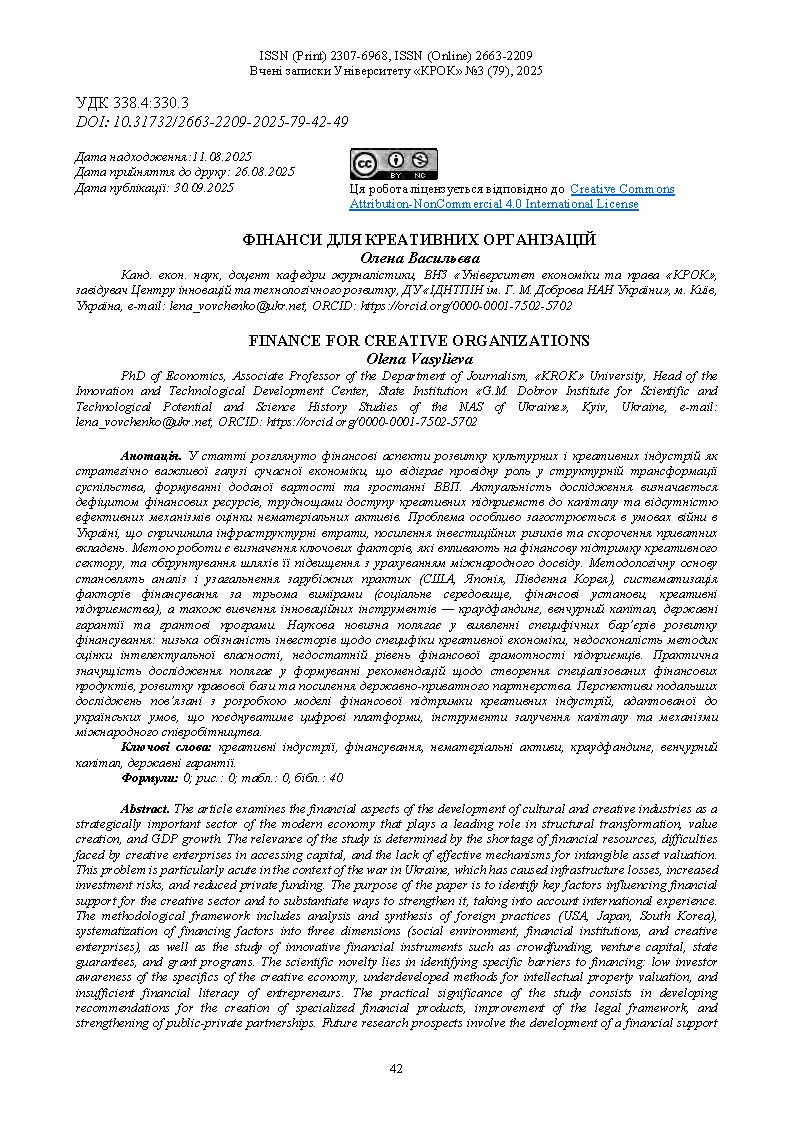ФІНАНСИ ДЛЯ КРЕАТИВНИХ ОРГАНІЗАЦІЙ
DOI:
https://doi.org/10.31732/2663-2209-2025-79-42-49Ключові слова:
креативні індустрії, фінансування, нематеріальні активи, краудфандинг, венчурний капітал, державні гарантіїАнотація
У статті розглядаються фінансові аспекти розвитку культурних і креативних індустрій як стратегічно важливої галузі економіки, що відіграє ключову роль у структурній трансформації та зростанні ВВП. Актуальність дослідження зумовлена браком фінансової підтримки та труднощами доступу креативних підприємств до капіталу, особливо в умовах війни в Україні, що поглиблює інфраструктурні та інвестиційні бар’єри. Метою дослідження є виявлення факторів, що впливають на фінансову підтримку креативного сектору, та визначення ефективних механізмів її підвищення. Методологічну основу становлять аналіз і узагальнення міжнародного досвіду (США, Японія, Південна Корея), систематизація факторів фінансування за трьома вимірами (соціальне середовище, фінансові установи, креативні підприємства), а також вивчення інструментів фінансових інновацій — краудфандинг, венчурний капітал, державні гарантії. Наукові результати полягають у визначенні ключових бар’єрів фінансування: відсутність стандартизованих методик оцінки нематеріальних активів, низька обізнаність інвесторів про специфіку креативної економіки, недостатня фінансова грамотність підприємців. Обґрунтовано необхідність розвитку спеціалізованих фінансових продуктів, удосконалення правової бази та посилення державно-приватного партнерства. Перспективи подальших досліджень пов’язані з розробкою адаптованої до українських умов моделі фінансової підтримки креативних індустрій, що поєднує інструменти залучення капіталу, цифрові платформи та механізми міжнародного співробітництва.
Завантаження
Посилання
Безугла, Л. С., Лазакович, І. І. (2024). Креативні індустрії та креативна економіка: досвід України в умовах війни. Економіка та суспільство, 63. DOI: https://doi.org/10.32782/2524-0072/2024-63-30
Звіт Платформи Культурних Зв’язків (2024). Retrieved from https://www.cultureinexternalrelations.eu/wp-content/uploads/2024/07/DGEAC-CRP-UA-Report-July-2024-UA.pdf
Румик, І., Плетенецька, С., Царенок, О. (2023). Особливості управління фінансовими ресурсами підприємств в умовах воєнного стану. Вчені записки Університету «КРОК», №4 (72), 9–19. DOI: https://doi.org/10.31732/2663-2209-2023-72-9-19
Український культурний фонд (2025). Retrieved from https://ucf.in.ua
Bakhshi, H., Siepel, J., Carmona, L., Tarr, A. (2024). Unleashing Creativity: Fixing the finance gap in the creative industries. Retrieved from https://unleash.wearecreative.uk
Caniels, C. J., & Rietzschel, E. F. (2015). Organizing Сreativity: Creativity and innovation under constraints. Creativity and Innovation Management, 24(2), 184–196. DOI: https://doi.org/10.1111/caim.12123
Creative Economy Outlook (2024). Retrieved from https://unctad.org/publication/creative-economy-outlook-2024
Creative Industries (2025). Retrieved from https://www.ifc.org/en/what-we-do/sector-expertise/creative-industries
Creative Industries Mapping Document (1998). Retrieved from https://www.gov.uk/government/publications/creative-industries-mapping-documents-1998
Cunningham, S. D., Ryan, M., Keane, M. A., Ordonez, D. (2008). Financing Creative Industries in Developing Country Contexts. Retrieved from https://www.researchgate.net/publication/27464633_Financing_Creative_Industries_in_Developing_Country_Contexts
Florida, R. (2002). The Rise of the Creative Class. Basic Books.
Hawkins, S. (2001). The Creative Economy: How People Make Money from Ideas. Penguin Books.
Hayes, A. (2024). What Is Venture Capital? Definition, Pros, Cons, and How It Works. Retrieved from https://www.investopedia.com/terms/v/venturecapital.asp
Higson, C., Rivers, O., & Deboo, M. (2007). Creative financing. Business Strategy Review, 18(4), 49–53.
Holmes, T. (1999). Localization of industry and vertical disintegration. The Review of Economics and Statistics, 81(2), 314–325.
Hottenrott, H., & Peters, B. (2012). Innovative capability and financing constraints for innovation: More money, more innovation? The Review of Economics and Statistics, 94(4), 1126–1142.
Huber, F. (2012). Do clusters really matter for innovation practices in information technology? Questioning the significance of technological knowledge spillovers. Journal of Economic Geography, 12(1), 107–126.
Keane, M. A. (2009). The Capital Complex: Beijing’s New Creative Clusters. In L. Kong & J. O’Connor (Eds.), Creative Economies, Creative Cities: Asia-European Perspectives (pp. 77–95). Springer.
Kim, K., Hong, E., & Rho, S. (2013). The study of defined buying factors affecting trust building and service performance in financial management systems. Mathematical and Computer Modelling, 58(1-2), 38–48.
Korea Creative Content Agency (2025). Retrieved from https://www.kocca.kr/en/main.do
Lam, J. (2006). Managing risk across the enterprise: hallenges and benefits. Risk management-a modern perspective. Stuart Graduate School of Business.
Liu, X. Y. (2006). Research on Risk Control Mechanism of Commercial Banks. Journal of Financial Research, 7, 78–85.
Local Employment and Economic Development Programme (2025). Retrieved from https://www.oecd.org/en/about/programmes/leed-programme.html
Lytovchenko, Y., Tomakh, V. (2023). Creative Economy: Opportunities for Rebuilding Ukraine. Науковий вісник Херсонського державного університету. Серія: Економічні науки, 48, 10-18. DOI: 10.32999/ksu2307-8030/2023-48-2
Maicon, O., Glauco, H., Andrei, A., & Henrique, R. (2018). Lessons learned from a successful industrial product service system business model: Emphasis on financial aspects. Journal of Business and Industrial Marketing, 33(3), 365–376. DOI: 10.1108/JBIM-07-2016-0147
Miska, C., Szocs, I., & Schiffinger, M. (2018). Culture’s effects on corporate sustainability practices: A multi- domain and multi-level view. Journal of World Business, 53(2), 263–279. DOI: 10.1016/j.jwb.2017.12.001
Mollick, E. (2013). The dynamics of crowdfunding: An exploratory study. Journal of Business Venturing, 29 (1), 1-16. DOI: https://doi.org/10.1016/j.jbusvent.2013.06.005
National Endowment for the Arts (2025). Retrieved from https://www.arts.gov
Nonaka, I. (1995). The knowledge-creating company: how Japanese companies create the dynamics of innovation. Oxford University Press.
OECD Report on Japan's Creative Economy (2025). Retrieved from https://www.oecd.org
Owen, R. (2018). Financing new creative enterprise through blockchain technology: Opportunities and policy implications. Strategic Change, 28(1), 9-17. DOI: https://doi.org/10.1002/jsc.2242
Perera, R. S. (2017). An optimal investment and risk control policy for a bank under exponential utility. Stochastic Models, 33(3), 343–375. DOI: 10.1080/15326349.2017.1300775
Petrenko N. S., Vovchenko O. V. (2023, вересень). Crowdfunding in Ukraine: problems and prospects for the development of an alternative way of financing science. 2023 IEEE 13th International Conference on ELECTRONICS AND INFORMATION TECHNOLOGIES (ELIT) PROCEEDINGS. Lviv, Retrieved from https://ieeexplore.ieee.org/document/10310851/metrics#metrics
Scott, A. J. (2010). Cultural economy and the creative field of the city. Geografiska Annaler. Series B, Human Geography, 92(2), 115–130.
Scott, A. J. (2014). Beyond the creative city: Cognitive-cultural capitalism and the new urbanism. Regional Studies, 48(4), 565–578.
SME Finance Monitor (2011). Retrieved from https://www.bva-bdrc.com/sme-finance-monitor/
Song, R., Moon, S., Chen, H. P., & Houston, M. B. (2018). When marketing strategy meets culture: The role of culture in product evaluations. Journal of the Academy of Marketing Science, 46(3), 384–402. DOI: 10.1007/ s11747-017-0525-x
U.S. Small Business Administration (2025). Retrieved from https://www.sba.gov
Williamson, E. (1975). Markets and hierarchies: analysis and antitrust implications, a Study in the economics of internal organization. Free Press.
World Bank Report on South Korea (2025). Retrieved from https://www.worldbank.org/en/country/korea
Zhang, J., Souitaris, V., Soh, P., & Wong, P. (2008). A contingent model of network utilization in early financing of technology ventures. Entrepreneurship Theory and Practice, 32(4), 593-613.

Downloads
Опубліковано
Як цитувати
Номер
Розділ
Ліцензія

Ця робота ліцензується відповідно до Creative Commons Attribution-NonCommercial 4.0 International License.

